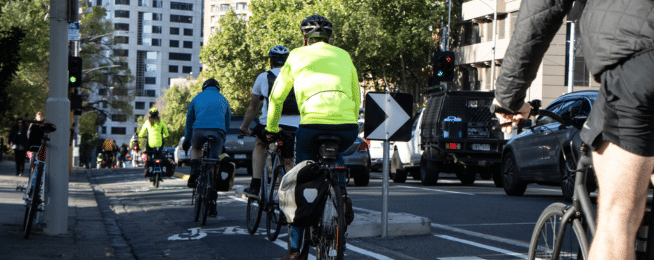The City of Melbourne has updated its plans for a comprehensive bike lane network through central Melbourne, reprioritising construction, switching to better quality and more attractive materials, and, regrettably delaying work on some vitally important routes.
The Future Melbourne Committee voted on Tuesday to endorse the new plan.
Fortunately, the pipeline of projects is now again flowing with Grattan Street bike lane project already underway.
Others in the queue and ready to go are Arden Street, Royal Parade, Abbotsford Street and Exhibition Street, with Macauley Road and Queensberry Street lining up.
Exhibition Street, along with William Street, Queens Bridge Street and Whiteman Street already have bike lanes constructed out of adjustable kerbing, but these are expected to be upgraded to more durable materials and attractive designs.
Projects that will not be delivered this financial year as expected, but are now delayed, include Flinders Street, Bourke Street and Spring Street. The committee report says that "to proceed with these works would have been too disruptive to the transport network given the number of major state project currently underway in the Hoddle Grid."
Bicycle Network Chief Executive Alison McCormack said it was crucial that the council keeps on course with its transport strategy.
“With the recent opening of the St Kilda Road bike infrastructure, with the Veloway from the west next year, and with massive changes in rail capacity with the opening of Metro Tunnel, central Melbourne needs to become much more accessible to active and public transport users.
“Bike lanes have been proved to reduce congestion, reduce the risk of crashes and make our streets more appealing places to visit, meet and shop.
"Melbourne is transforming into a thriving hive of social activity and commerce and we have to keep making easier for people to get here and enjoy themselves."
Inner Melbourne's bike routes are now essential to Melbourne’s economy, transporting tens of thousands of workers, students and visitors to and through the CBD each day.
Streets have long been saturated with motor traffic, with no capacity for expansion, leaving active transport and public transport to carry us forward.
The bike network has the potential to expand indefinitely, doubling its numbers every five to ten years for decades: but only if a fully connected network of routes is in place.
Back in 2020 the council committed to the accelerated delivery of 44km of bikes lanes across the city, managing just 18.7km of that so far, although an additional 2.1km not in the program managed to squeeze through the gate.
The bike lanes now on the list have been previously approved by the City, most have been through public consultation and are in various stages of planning and design.
An evaluation of the bike projects completed so far show a remarkable uplift in safety:
- Crashes involving bike riders are down 10 per cent on project sites while pedestrian crashes are also down.
- The Exhibition Street bike lanes, initially controversial, have reduced crashes for all modes — bikes, pedestrians, and cars — by 46 per cent.
- Bike volumes on upgraded routes have increased by 22%, compared to routes which were not upgraded.
- The proportion of women riding bikes is 36 per cent on the separated network, compared to 24 per cent across CoM in 2018.
Preliminary Super Tuesday March 2024 bicycle count data showed that across City of Melbourne, women now make up 30% of people riding bikes.

Or become our friend and subscribe to receive our fortnightly newsletter.


